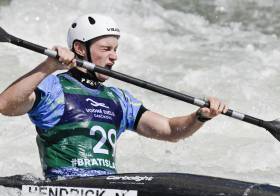Displaying items by tag: Noel Hendrick
Canoeist Noel Hendrick Qualifies Second Olympic Boat For Ireland at Paris 2024
In a historic win for Ireland, Noel Hendrick has secured the country's second Olympic quota place at the 2024 Canoe Slalom World Championships.
Despite immense pressure, Hendrick delivered a remarkable performance, finishing in 16th place and securing a spot in the K1M for the Paris 2024 Olympic Games.
This victory marks the end of Ireland's drought in the K1M category, with the last Irish representative being Eoin Rheinisch in London 2012. Rheinisch has coached Hendrick to this incredible performance this week.
 Madison Corcoran
Madison Corcoran
Ireland is also in a great position to secure qualification for the Paris Games in the K1 Women's category. Madison Corcoran is provisionally in line to be awarded a quota space from the 2023 European Games. The final decision will be made based on a countback of qualified nations from these World Championships.
#Canoeing: Noel Hendrick put in a solid performance in the men’s K1 semi-final at the canoe slalom World Under-23 Championships in Krakow, Poland, this morning. He had no touches, but his time of 91.46 seconds left him outside the top 10 who went through to the final. He finished 22nd.
Eoin Teague was off the pace in his run and was then thrown completely out of the reckoning at the finish when he misjudged gate 20 and was given a 50-second penalty.
Canoe Slalom World Under-23 Championships, Krakow (Irish interest)
K1 Semi-Final: 22 N Hendrick 91.46 seconds; 36 E Teague 144.24
#Canoeing: Ireland will have three paddlers in the semi-finals of under-23 events at the canoe slalom World Under-23 and Junior Championships at Krakow in Poland. Liam Jegou finished 10th on his first run in the C1, though he made a mistake on gate nine and had to go at it a second time. Noel Hendrick and Eoin Teague also qualified from their first runs in the K1.
Canoe Slalom World U23 and Junior Championships, Krakow, Poland (Irish interest; qualifiers)
Men
Under-23 C1, First Run: 10 L Jegou 100.89.
K1, First Run: 12 N Hendrick 96.08; 25 E Teague 99.15.
Noel Hendrick Straight Through to European Semi-Final
#Canoeing: Ireland paddler Noel Hendrick qualified for the semi-finals at the European Under-23 Championships today. The K1 competitor went straight through from the first run, taking 13th with a round with no touches at Liptovsky Mikulas in Slovakia. Eoin Teague fell just outside qualification in the same event in the second run.
Thirty of the 61 paddlers made it through to the semis. Hendrick will go off in the final 15 in the semi.
Hendrick and Jegou on Song in Slovakia
#Canoeing: Noel Hendrick qualified for his first semi-final in a big event and went on to make the final at the canoe slalom European Under-23 Championships in Bratislava. The Irishman finished ninth. It was a breaktrough for the young K1 paddler.
Liam Jegou also made it through the C1 semi-finals on Sunday.

























































